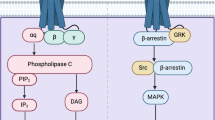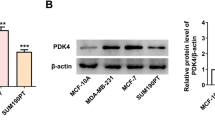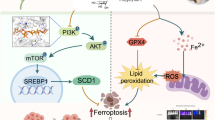Abstract
Fluoxetine (FLX) is an antidepressant drug that belongs to the class of selective serotonin reuptake inhibitors. FLX is known to induce apoptosis in multiple types of cancer cells. In this study, the molecular mechanisms underlying the anti-cancer effects of FLX were investigated in SK-N-BE(2)-M17 human neuroblastoma cells. FLX induced apoptotic cell death, activation of caspase-4, -9, and -3, and expression of endoplasmic reticulum (ER) stress-associated proteins, including C/EBP homologous protein (CHOP). Inhibition of ER stress by treatment with the ER stress inhibitors, salubrinal and 4-phenylbutyric acid or CHOP siRNA transfection reduced FLX-induced cell death. FLX induced phosphorylation of mitogen-activated protein kinases (MAPKs) family, p38, JNK, and ERK, and an upstream kinase apoptosis signal kinase 1 (ASK1). Inhibition of MAPKs and ASK1 reduced FLX-induced cell death and CHOP expression. We then showed that FLX reduced mitochondrial membrane potential (MMP) and ER stress inhibitors as well as MAPK inhibitors ameliorated FLX-induced loss of MMP. Interestingly, FLX induced hyperacetylation of histone H3 and H4, upregulation of p300 histone acetyltransferase (HAT), and downregulation of histone deacetylases (HDACs). Treatment with a HAT inhibitor anacardic acid or p300 HAT siRNA transfection blocked FLX-induced apoptosis in SK-N-BE(2)-M17 cells. However, FLX did not induce histone acetylation and anacardic acid had no protective effect on FLX-induced cell death and CHOP expression in MYCN non-amplified SH-SY5Y human neuroblastoma and MYCN knockdowned SK-N-BE(2)-M17 cells. These findings suggest that FLX induces apoptosis in neuroblastoma through ER stress and mitochondrial dysfunction via the ASK1 and MAPK pathways and through histone hyperacetylation in a MYCN-dependent manner.









Similar content being viewed by others
Change history
30 September 2022
This article has been retracted. Please see the Retraction Notice for more detail: https://doi.org/10.1007/s10495-022-01772-7
References
Dasgupta R, Billmire D, Aldrink JH, Meyers RL (2017) What is new in pediatric surgical oncology? Curr Opin Pediatr 29:3–11
Schor NF (2009) New approaches to pharmacotherapy of tumors of the nervous system during childhood and adolescence. Pharmacol Ther 122:44–55
Bielecka AM, Obuchowicz E (2013) Antidepressant drugs as a complementary therapeutic strategy in cancer. Exp Biol Med 238:849–858
Serafeim A, Holder MJ, Grafton G et al (2003) Selective serotonin reuptake inhibitors directly signal for apoptosis in biopsy-like Burkitt lymphoma cells. Blood 101:3212–3219
Cloonan SM, Williams DC (2011) The antidepressants maprotiline and fluoxetine induce Type II autophagic cell death in drug-resistant Burkitt’s lymphoma. Int J Cancer 128:1712–1723
Levkovitz Y, Gil-Ad I, Zeldich E, Dayag M, Weizman A (2005) Differential induction of apoptosis by antidepressants in glioma and neuroblastoma cell lines: evidence for p-c-Jun, cytochrome c, and caspase-3 involvement. J Mol Neurosci 27:29–42
Liu KH, Yang ST, Lin YK et al (2015) Fluoxetine, an antidepressant, suppresses glioblastoma by evoking AMPAR-mediated calcium-dependent apoptosis. Oncotarget 6:5088–5101
Krishnan A, Hariharan R, Nair SA, Pillai MR (2008) Fluoxetine mediates G0/G1 arrest by inducing functional inhibition of cyclin dependent kinase subunit (CKS)1. Biochem Pharmacol 75:1924–1934
Lee CS, Kim YJ, Jang ER, Kim W, Myung SC (2010) Fluoxetine induces apoptosis in ovarian carcinoma cell line OVCAR-3 through reactive oxygen species-dependent activation of nuclear factor-κB. Basic Clin Pharmacol Toxicol 106:446–453
Bowie M, Pilie P, Wulfkuhle J et al (2015) Fluoxetine induces cytotoxic endoplasmic reticulum stress and autophagy in triple negative breast cancer. World J Clin Oncol 6:299–311
Breckenridge DG, Germain M, Mathai JP, Nguyen M, Shore GC (2003) Regulation of apoptosis by endoplasmic reticulum pathways. Oncogene 22:8608–8618
Brenner D, Mak TW (2009) Mitochondrial cell death effectors. Curr Opin Cell Biol 21:871–877
Harding HP, Zhang Y, Ron D (1999) Protein translation and folding are coupled by an endoplasmic-reticulum-resident kinase. Nature 397:271–274
Rao RV, Ellerby HM, Bredesen DE (2004) Coupling endoplasmic reticulum stress to the cell death program. Cell Death Differ 11:372–380
Oyadomari S, Mori M (2004) Roles of CHOP/GADD153 in endoplasmic reticulum stress. Cell Death Differ 11:381–389
Zinszner H, Kuroda M, Wang X et al (1998) CHOP is implicated in programmed cell death in response to impaired function of the endoplasmic reticulum. Genes Dev 12:982–995
Choi JH, Lee JY, Choi AY et al (2012) Apicidin induces endoplasmic reticulum stress- and mitochondrial dysfunction-associated apoptosis via phospholipase Cγ1- and Ca(2+)-dependent pathway in mouse Neuro-2a neuroblastoma cells. Apoptosis 17:1340–1358
Grunstein M (1997) Histone acetylation in chromatin structure and transcription. Nature 389:349–352
Wade PA, Pruss D, Wolffe AP (1997) Histone acetylation: chromatin in action. Trends Biochem Sci 22:128–132
Shahbazian MD, Grunstein M (2007) Functions of site-specific histone acetylation and deacetylation. Annu Rev Biochem 76:75–100
Kaur J, Tikoo K (2013) p300/CBP dependent hyperacetylation of histone potentiates anticancer activity of gefitinib nanoparticles. Biochim Biophys Acta 1833:1028–1040
Wu TC, Lin YC, Chen HL, Huang PR, Liu SY, Yeh SL (2016) The enhancing effect of genistein on apoptosis induced by trichostatin A in lung cancer cells with wild type p53 genes is associated with upregulation of histone acetyltransferase. Toxicol Appl Pharmacol 292:94–102
Witt O, Deubzer HE, Milde T, Oehme I (2009) HDAC family: what are the cancer relevant targets? Cancer Lett 277:8–21
Somech R, Izraeli S, A JS (2004) Histone deacetylase inhibitors—a new tool to treat cancer. Cancer Treat Rev 30:461–472
Covington HE 3rd, Maze I, LaPlant QC et al (2009) Antidepressant actions of histone deacetylase inhibitors. J Neurosci 29:11451–11460
Han A, Sung YB, Chung SY, Kwon MS (2014) Possible additional antidepressant-like mechanism of sodium butyrate: targeting the hippocampus. Neuropharmacology 81:292–302
Jochems J, Boulden J, Lee BG et al (2014) Antidepressant-like properties of novel HDAC6-selective inhibitors with improved brain bioavailability. Neuropsychopharmacology 39:389–400
Aires V, Hichami A, Filomenko R et al (2007) Docosahexaenoic acid induces increases in [Ca2+]i via inositol 1,4,5-triphosphate production and activates protein kinase Cγ and -δ via phosphatidylserine binding site: implication in apoptosis in U937 cells. Mol Pharmacol 72:1545–1556
Di Fazio P, Ocker M, Montalbano R (2012) New drugs, old fashioned ways: ER stress induced cell death. Curr Pharm Biotechnol 13:2228–2234
Darling NJ, Cook SJ (2014) The role of MAPK signalling pathways in the response to endoplasmic reticulum stress. Biochim Biophys Acta 1843:2150–2163
Wang XZ, Ron D (1996) Stress-induced phosphorylation and activation of the transcription factor CHOP (GADD153) by p38 MAP kinase. Science 272:1347–1349
Urano F, Wang X, Bertolotti A et al (2000) Coupling of stress in the ER to activation of JNK protein kinases by transmembrane protein kinase IRE1. Science 287:664–666
Hattori K, Naguro I, Runchel C, Ichijo H (2009) The roles of ASK family proteins in stress responses and diseases. Cell Commun Signal 7:9
Lin T, Chen Y, Ding Z, Luo G, Liu J, Shen J (2013) Novel insights into the synergistic interaction of a thioredoxin reductase inhibitor and TRAIL: the activation of the ASK1-ERK-Sp1 pathway. PLoS ONE 8:e63966
Choi AY, Choi JH, Hwang KY et al (2014) Licochalcone A induces apoptosis through endoplasmic reticulum stress via a phospholipase Cgamma1-, Ca(2+)-, and reactive oxygen species-dependent pathway in HepG2 human hepatocellular carcinoma cells. Apoptosis 19:682–697
Bratton MR, Frigo DE, Vigh-Conrad KA et al (2009) Organochlorine-mediated potentiation of the general coactivator p300 through p38 mitogen-activated protein kinase. Carcinogenesis 30:106–113
Meissner JD, Freund R, Krone D et al (2011) Extracellular signal-regulated kinase 1/2-mediated phosphorylation of p300 enhances myosin heavy chain I/β gene expression via acetylation of nuclear factor of activated T cells c1. Nucleic Acids Res 39:5907–5925
Tsai YJ, Tsai T, Peng PC, Li PT, Chen CT (2015) Histone acetyltransferase p300 is induced by p38MAPK after photodynamic therapy: the therapeutic response is increased by the p300HAT inhibitor anacardic acid. Free Radic Biol Med 86:118–132
Broide RS, Redwine JM, Aftahi N, Young W, Bloom FE, Winrow CJ (2007) Distribution of histone deacetylases 1–11 in the rat brain. J Mol Neurosci 31:47–58
He S, Liu Z, Oh DY, Thiele CJ (2013) MYCN and the epigenome. Front Oncol 3:1
Marshall GM, Gherardi S, Xu N et al (2010) Transcriptional upregulation of histone deacetylase 2 promotes Myc-induced oncogenic effects. Oncogene 29:5957–5968
Sun Y, Liu PY, Scarlett CJ et al (2014) Histone deacetylase 5 blocks neuroblastoma cell differentiation by interacting with N-Myc. Oncogene 33:2987–2994
Pession A, Tonelli R (2005) The MYCN oncogene as a specific and selective drug target for peripheral and central nervous system tumors. Curr Cancer Drug Targets 5:273–283
Kannen V, Hintzsche H, Zanette DL et al (2012) Antiproliferative effects of fluoxetine on colon cancer cells and in a colonic carcinogen mouse model. PLoS ONE 7:e50043
Zhou T, Duan J, Wang Y et al (2012) Fluoxetine synergys with anticancer drugs to overcome multidrug resistance in breast cancer cells. Tumour Biol 33:1299–1306
Boya P, Cohen I, Zamzami N, Vieira HL, Kroemer G (2002) Endoplasmic reticulum stress-induced cell death requires mitochondrial membrane permeabilization. Cell Death Differ 9:465–467
Choi AY, Choi JH, Yoon H et al (2011) Luteolin induces apoptosis through endoplasmic reticulum stress and mitochondrial dysfunction in Neuro-2a mouse neuroblastoma cells. Eur J Pharmacol 668:115–126
Orrenius S, Zhivotovsky B, Nicotera P (2003) Regulation of cell death: the calcium-apoptosis link. Nat Rev Mol Cell Biol 4:552–565
Lin KL, Chou CT, Cheng JS et al (2014) Effect of fluoxetine on [Ca(2)(+)]i and cell viability in OC2 human oral cancer cells. Chin J Physiol 57:256–264
Song C, Kanthasamy A, Anantharam V, Sun F, Kanthasamy AG (2010) Environmental neurotoxic pesticide increases histone acetylation to promote apoptosis in dopaminergic neuronal cells: relevance to epigenetic mechanisms of neurodegeneration. Mol Pharmacol 77:621–632
Covington HE 3rd, Vialou VF, LaPlant Q, Ohnishi YN, Nestler EJ (2011) Hippocampal-dependent antidepressant-like activity of histone deacetylase inhibition. Neurosci Lett 493:122–126
Covington HE 3rd, Maze I, Vialou V, Nestler EJ (2015) Antidepressant action of HDAC inhibition in the prefrontal cortex. Neuroscience 298:329–335
Schroeder FA, Lin CL, Crusio WE, Akbarian S (2007) Antidepressant-like effects of the histone deacetylase inhibitor, sodium butyrate, in the mouse. Biol Psychiatry 62:55–64
Meylan EM, Halfon O, Magistretti PJ, Cardinaux JR (2016) The HDAC inhibitor SAHA improves depressive-like behavior of CRTC1-deficient mice: possible relevance for treatment-resistant depression. Neuropharmacology 107:111–121
Li L, Qin X, Shi M et al (2012) Regulation of histone acetylation by NDRG2 in glioma cells. J Neurooncol 106:485–492
Acknowledgements
This work was supported by the National Research Foundation of Korea (NRF) grants funded by the Korea government (Nos. 2011-0030721; 2015R1D1A1A01057508) and a grant of the Korea Health Technology R&D Project through the Korea Health Industry Development Institute (KHIDI) funded by the Ministry of Health & Welfare, Republic of Korea (No. HI14C2700).
Author information
Authors and Affiliations
Corresponding authors
Ethics declarations
Conflict of interest
The authors declare that they have no conflict of interest.
Electronic supplementary material
Below is the link to the electronic supplementary material.
Fig. S1
Effects of FLX on ER stress and histone acetylation in U251MG human glioblastoma cells. a Cells were treated with vehicle or 25 μM FLX for the indicated times. Cell lysates were analyzed by Western blot with antibodies against CHOP, sXBP-1, ATF6α (p90), cleaved caspase-4(C), and β-actin. b, c cells were preincubated with 10 μM salubrinal or 1 mM 4-PBA for 1 h and then treated with FLX for 24 h. Cell viability was determined by MTT assay and the percent viabilities are plotted as the mean ± standard deviation of at least three experiments (b). The protein levels of CHOP and β-actin were detected by Western blot analysis (c). d, e Cells were pretreated with 5 μM anacardic acid (AA) for 1 h or transfected with Scr control or p300 siRNA for 24 h and then followed by FLX for 24 h. Cell viability was determined by MTT assay and the percent viabilities are plotted as the mean ± standard deviation of at least three experiments (d). Cell lysates were analyzed by Western blot with antibodies against CHOP, cleaved caspase-4(C), Ac-H3, Ac-H4, p300, and β-actin (e). f Cells were treated with FLX for the indicated times. Cell lysates were analyzed by Western blot with antibodies against HDACs 1-6, Ac-H3, Ac-H4, and β-actin. *P < 0.01 and **P < 0.01 compared with vehicle- or Scr siRNA-treated cells. #P < 0.01 and ##P < 0.01 compared with FLX-treated cells with vehicle (b) or Scr siRNA transfection (d) (JPG 72 kb)
Fig. S2
Effects of MYCN on FLX-induced histone hyperacetylation in U251MG cells. a Cells were transfected with Scr control or MYCN siRNA for 24 h. Cells were then treated with vehicle or 5 μM anacardic acid (AA) for 1 h and followed by 15 μM FLX for 24 h. Cell viability was determined by MTT assay. *P < 0.01 compared with vehicle-treated cells with Scr siRNA transfection. #P < 0.01 compared with FLX-treated cells with Scr siRNA transfection. b After Scr or MYCN siRNA transfection for 24 h, cells were treated with 15 μM FLX for 12 or 24 h. Cell lysates were subjected to Western blot with antibodies against CHOP, cleaved caspase-4(C), Ac-H3, Ac-H4, HDACs 1-4, p300, N-Myc, and β-actin (JPG 42 kb)
About this article
Cite this article
Choi, J.H., Jeong, Y.J., Yu, AR. et al. RETRACTED ARTICLE: Fluoxetine induces apoptosis through endoplasmic reticulum stress via mitogen-activated protein kinase activation and histone hyperacetylation in SK-N-BE(2)-M17 human neuroblastoma cells. Apoptosis 22, 1079–1097 (2017). https://doi.org/10.1007/s10495-017-1390-2
Published:
Issue Date:
DOI: https://doi.org/10.1007/s10495-017-1390-2




